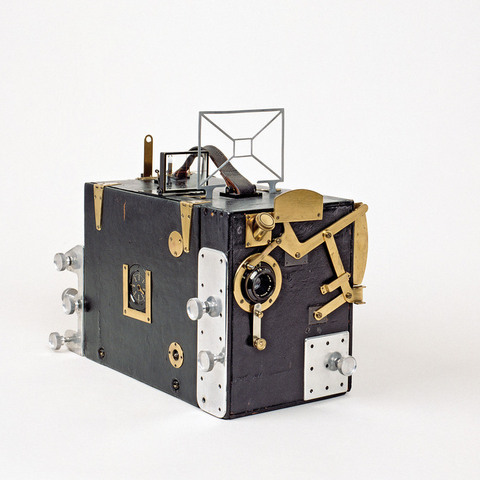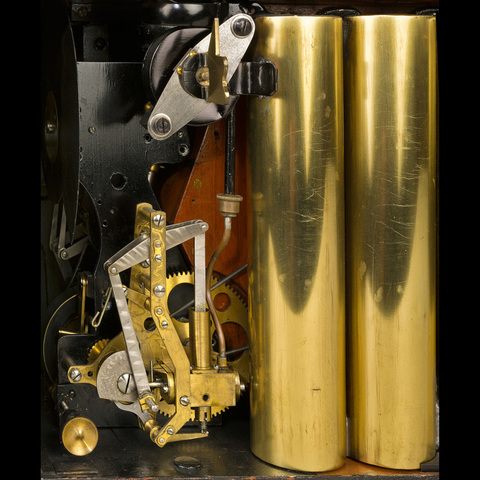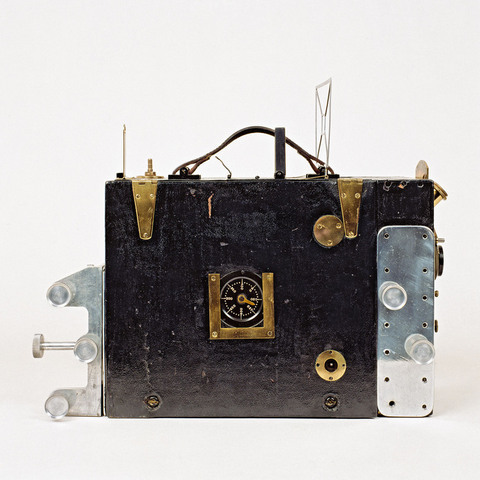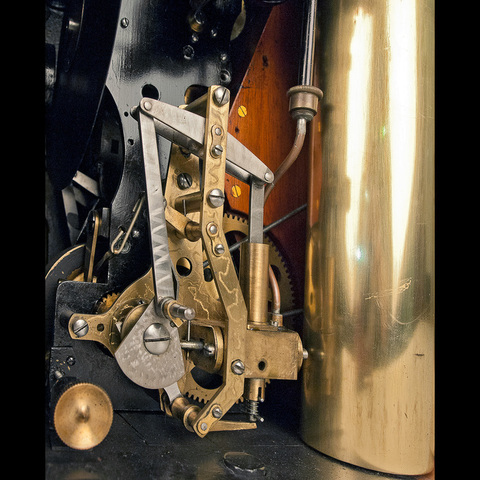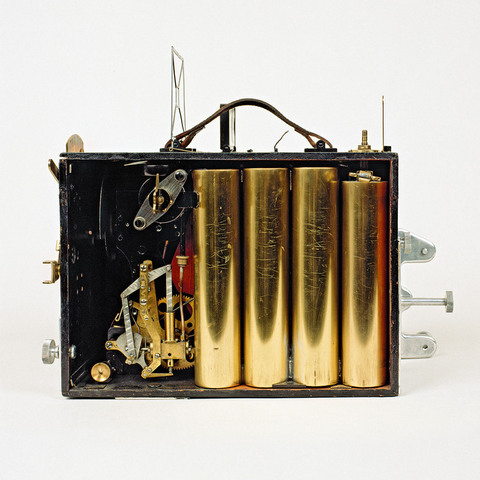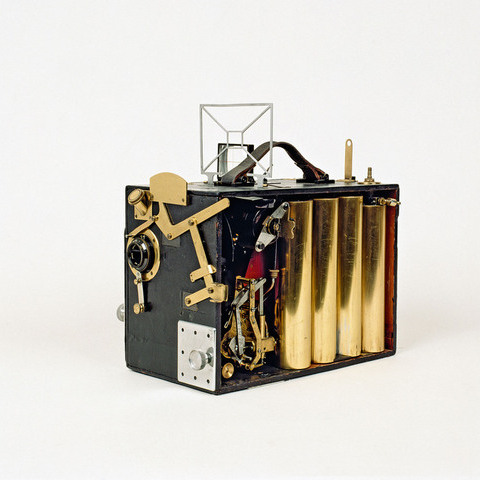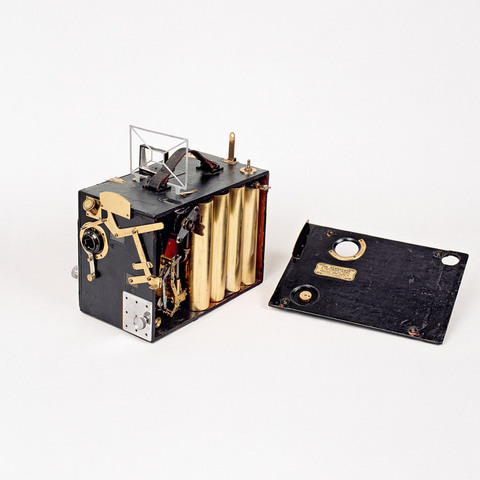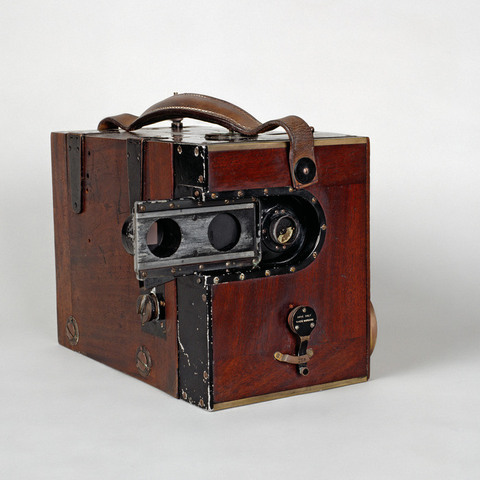Caméra film 35 mm à air comprimé
Fiche détaillée
Type de l'appareil
entraînement du film 35 mm par deux griffes ; piston relié par trois tiges métalliques à une came excentique qui fait mouvoir par arbres deux débiteurs dentés, l'obturateur à une pale et le cadre porte-griffes ; deux magasins intérieurs ; quatre cylindres à air en cuivre avec bec sur le haut pour insuffler l'air au moyen d'une pompe ; viseur à lentille ; pointeur métallique ; compteur de métrage ; réglage de la mise au point par levier extérieur ; système de poignées E.R. Calthrop's
Auteurs
Proszynski Kasimir
Paris
Fabricants
Newman & Sinclair Ltd
Londres, Highgate
Cherry Kearton LTD
Londres, Dewar House, 11 Haymarket
Utilisateurs
Proszynski Kasimir
Paris
Distributeurs
Cherry Kearton LTD
Londres, Dewar House, 11 Haymarket
Sujet du modèle
Informations non disponibles
Objectif
2 in. f. 3,5 n° 76 175 Ross London Patent
Taille de l'objet
Ouvert :
Informations non disponibles
Fermé :
Longueur : 47 cm
Largeur : 24 cm
Hauteur : 37 cm
Diamètre :
Informations non disponibles
Taille de la boîte de transport
Informations non disponibles
Remarques
Plaque cuivre sur le côté : "The Aeroscope. K. Proszynski's Patents. Eng. n° 6203/10 and 9829/12. Manufacturers : Cherry Kearton LTD, 11 Haymarket, London S.W." Gravé sur le système ajouté des poignées : "E.R. Calthrop's Automatic Biograph Camera Carrier. Provisionaly Protected n° 11 868/15. N°1".
"The camera is divided into two main compartments, one containing the mechanism, motor, gyroscope, reservoir, etc. ; and the other the film boxes, to which a door on the right side of the camera gives access. The film-boxe compartment is the only one that need be opened by the operator ; and the threading of the machine is simple. (...) The lenses are fitted directly to the metal framework of the mechanism, and do not depend for support on the wood case. (...) The reservoir is filled with air by means of a pump, similar to that used for cycle tyres." (Kasimir Proszynski, The Aeroscope, a Most Wonderful Invention, Londres, Cherry Kearton Limited, s.d. , pp. 11 & 19).
"Kazimierz Proszynski (1875-1945) was born in Warsaw in 1875, son of a well-known writer on educational topics. [...] For the three years between 1907 and 1910, Proszynski was working on a hand cinematographic camera. It was described to the French Academy of Sciences in 1910 by Professor Lipmann, under its provisonal name of Autopleograf. It became better known however as the Aeroscope, and its main development lay in London rather than in Paris. Proszynski was working in London from 1911 or 1912 until 1915, but already in March 1910 he had applied for an English patent of the Aeroscope. The specification (6203, 1910) states that "this invention has for its object a practical and complete solution of the problem which until now has been considered as being impossible to carry out" - i.e. that of producing an easily manipulated portable cine camera with an adequate source of power. The source of power was air, compressed by means of a triple expansion pump and contained under pressure, at 400 lb per sq. inch, in cylinders in one compartment of the camera. The air from this "reservoir", suitably reduced to 30 lb per sq. inch, drove the motor. The air reservoir and motor occupied one side of the whole box ; in the other side were located the mechanism for moving the film and the magazines holding some 400 feet of film. The apparatus, which was the first successful type of cine camera with a self-contained driving mechanism, was demonstrated at a technical meeting of the Royal Photographic Society in London, in February 1913, but it is clear that production had begun the previous year. The Aeroscope was operated at the demonstration by A. S. Newman, a founder of the firm of Newman and Sinclair, and the films had been made by Cherry Kearton, already well-known as a nature photographer. One film showed the possibilities of the Aeroscope in recording a London procession, the others, taken in the Yellowstone Park, USA, its value in photographing wild animal life. Kearton was acquainted with the Aeroscope from soon after Proszinski's arrival in England to work with the progressive Warwick Trading Co. with which Kearton himself was closely associated. The new camera at once appealed to Kearton and he used it, in fact, over a number of years. He took the Aeroscope up in the Spencer brothers' balloon for aerial cine-photography of London in 1912 or 1913, employed it when an official war photographer in South Africa (1915-1918) and shot with it some of the famous film material described in books such as Wild Life across the World (1913) and Through Central Africa from East to West (1915). Paul J. Rayney, the American, also used an Aeroscope for the nine-reel African hunt film which appeared in 1912-13. Geoffrey Malins, at one time editor of Gaumont Graphic newsreel and later War Office kinematographer, used Aeroscope cameras notably for reportage work at the front (1914-18), and in 1922, when he accompanied Major W. T. Blake on his attempted flight round the world (see How I Filmed the War, Malins, 1920, and Flying Round the World, Blake, 1923). The Aeroscope found favour generally for newsreel work. Frank Danvers Yates, a leading Warwick Trading Co. newsreel man, used it consistently in the earliest days. A set of three was used to shoot the weekly Gaumont Graphic in 1913-15, and throughout the 1920's others were regularly employed at football and boxing matches, and at race meetings by Gaumont, Pathé, Tropical, Paramount and Movietone. State occasions were also recorded - for instance scenes of the coronation of King George V, filmed by Proszynski himself, and the funeral of Queen Alexandra, filmed for Pathé. The Aeroscope was used for aerial cine-photography both by Pathé and by Paramount. During the 1920's the capacity of the Aeroscope was in some cases extended by the addition of improved sighting devices (e.g. telescope sightings for Topical made by Kingston & Lynes Ltd), and the air was sometimes supplied from a cylinder carried in the film company's van (Movietone). The idea of giving the camera an electrical drive as alternative to the compressed air existed but was not to be easily arrived at, with the inadequacies of the batteries then available. An attempt was made in Poland, however, between 1911 and 1912, where Proszynski's collaborator Marian Sitkiewicz, evolved a "knapsack" of aluminium lined with lead to take portable accumulators. The Aeroscope was manufactured in England first by Newman & Sinclair, and marketed by Cherry Kearton Ltd, then by F. Van Neck, who distributed it through Eracam Ltd, a company formed by him. [...] In August of 1944, Proszynski was arrested by the Germans and sent to Gross-Rosen concentration camp and thence to Malthausen, where he died in March 1945" (Bernard & Elizabeth Orna, tapuscrit, Londres, avril 1956).
"L'accumulateur d'énergie, dans cet appareil, est un réservoir à air comprimé. [...] Pour que le réservoir supporte une forte pression et qu'il remplisse le plus économiquement la place restant libre dans l'appareil, il se compose de plusieurs tubes de petit diamètre. L'appareil ainsi conçu peut rester chargé très longtemps et est toujours prêt à n'importe quel moment à fonctionner. [...] Pour charger l'appareil il suffit de le poser à terre sur le côté et de visser le bout du tuyau de la pompe à pied sur la valve" (Casimir de Proszynski, France, BF n° 408 435, demandé le 22 janvier 1909, délivré le 24 janvier 1910, "Appareil cinématographique portatif pour la prise des vues").
Bibliographie
Kasimir Proszynski, The Aeroscope, a Most Wonderful Invention, Londres, Cherry Kearton Limited, s.d.
